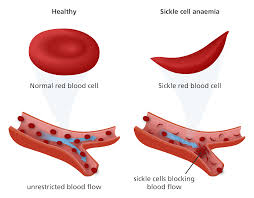Awareness and Knowledge of Sickle Cell Disease in Rivers State, Nigeria

Abstract:
Previous study has assessed patient
awareness about management of
sickle cell disease (SCD) which indicates that there is a lack of awareness about
the disease and possibly a need for more awareness. Therefore, our study aimed at Awareness
& Knowledge of Sickle Cell Disease in Rivers State, Nigeria. The study was conducted from October 2018 to February 2019.
A questionnaire was distributed among 154 persons selected from among the general
public. Most (75.0%) had heard of SCD and 35.0% knew that it can be diagnosed by
a blood test, but 33.3% did not know the prevalence of SCD in Nigeria. 50(41.7%) recognized it as a
hereditary disorder. Professional/university students gave the most correct answers;
Females showed better knowledge than males and married persons seems to know more
about SCD than unmarried ones. There is a fair level of knowledge about SCD among
the respondents, though some of the respondents were confused about the difference
between the carrier state of a disease and the disease itself. Health
education should be intensified to impact sufficient comprehensive knowledge about
SCD to enable the public take informed decision about their marriage so as to prevent
procreation of children affected with SCD.
Keywords: Awareness, Knowledge Sickle Cell Disease, Rivers State,
Nigeria.
References:
[1]. Adewuyi,
J., O. (2000): Knowledge of and attitudes to sickle cell disease and sickle carrier
screening among new graduates of Nigerian tertiary educational institutions. Niger
Postgrad Med J 7:120-3.
[2]. Boyd,
J., H., Watkins, A., R., Price, C., L., Fleming, F., & DeBaun, M., R. (2005):
Inadequate community knowledge about sickle cell disease among African-American
women. Journal of National Medical Assocication;
97:62-7.
[3]. Durotoye, I., A., Salaudeen, A., G., Babatunde,
A., S., Bosah, E., C., & Ajayi, F., D. (2013): Knowledge and Perception of Sickle
cell disease among Senior Secondary School students in Illorin Metropolis. The Tropical
Journal of Health Sciences; 20(2): 1-7.
[4]. Fleming,
A., F., Storey, J., Molineaux, L., Iroko, E., A., & Attai, E., D. (1979): “Abnormal
haemoglobins in the Sudan savanna of Nigeria. I. Prevalence of haemoglobins and
relationships between sickle cell trait, malaria and survival,” Annals of Tropical
Medicine and Parasitology, 73(2) 161–172.
[5]. Horton,
J., A., B. (1874): The Diseases of Tropical Climates and Their Treatment,
Churchill, London.
[6]. http://www.afro.who.int/en/nigeria/nigeria-publications/1775-sickle
cell disease.html.
[7]. Modell,
B. & Darlison, M. (2008): “Global epidemiology of haemoglobin disorders and
derived service indicators,” Bulletin
of the World Health Organization, 86(6): 480–487.
[8]. Nwogoh,
B., Adewoyin, A., S., Iheanacho, O., E. & Bazuaye, G., N. (2012): “Prevalence
of haemoglobin variants in Benin City, Nigeria,” Annals of Biomedical Sciences,
11(2):60–64.
[9]. Okwi
A. L., Byarugaba W., Ndugwa C. M., Parkes A., Ocaido M., & Tumwine J. K. (2010):
“An up-date on the prevalence of sickle cell trait in Eastern and Western Uganda,”
BMC Blood Disorders, 10:5.
[10]. Piel,
F., B., Patil A. P., & Howes, R., E. (2013): “Global epidemiology of Sickle
haemoglobin in neonates: a contemporary geostatistical model-based map and population estimates,” The Lancet,
381(9861)142–151.
[11]. Shaikha,
A., A, & Amani, A., H. (2010): Public
awareness of sickle cell disease in Bahrain; Ann Saudi Med; 30(4): 284-288.
[12]. Serjeant,
G., R. (1997) “Sickle-cell disease,” The Lancet; 350(9079)725–730,
[13]. Uzoegwu,
P., N., & Onwurah A. E. (2003): “Prevalence of haemoglobinopathy and malaria
diseases in the population of old Aguata Division, Anambra State, Nigeria,” Biokemistri,
15(2)57–66.
[14]. WHO
(2013): Regional office for Africa, Sickle cell disease prevention and control,
World Health Organisation, (2008): “Management of haemoglobin disorders in Proceedings
of the Report of Joint WHO-TIF Meeting, Nicosia, Cyprus.

